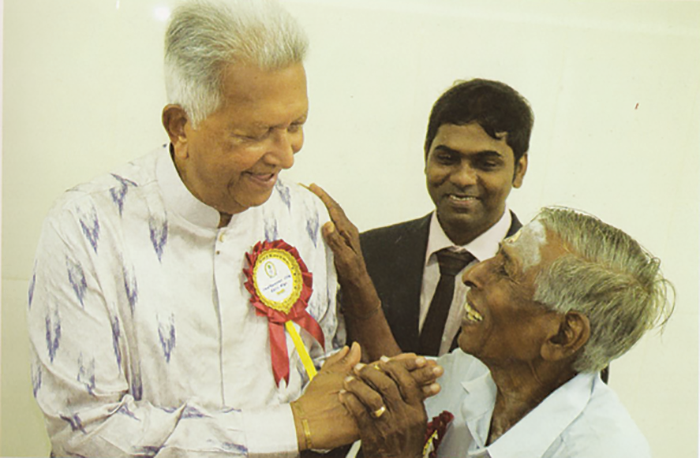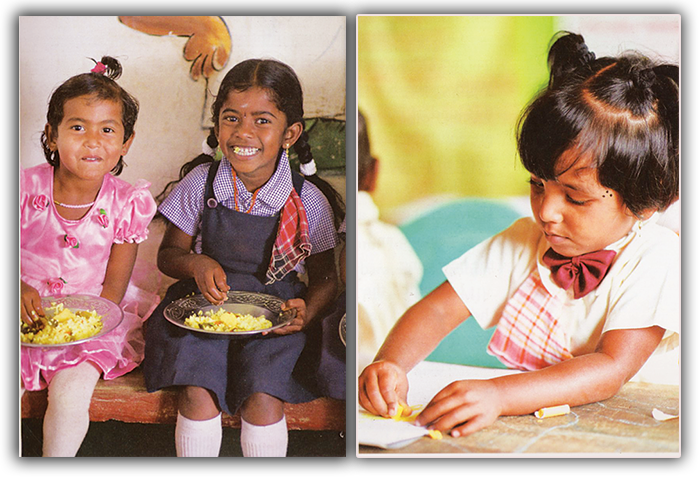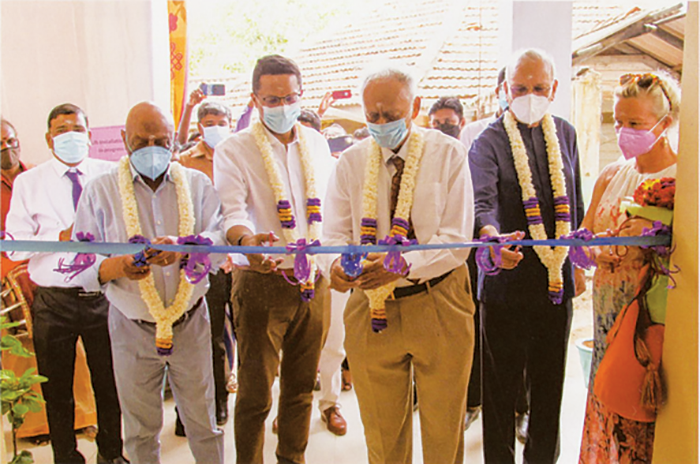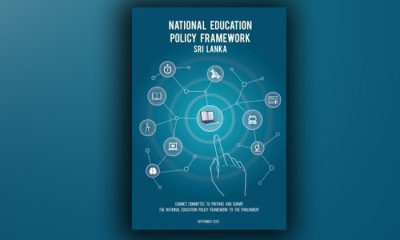Features
EDUCATION IN THE PLANTATION SECTOR
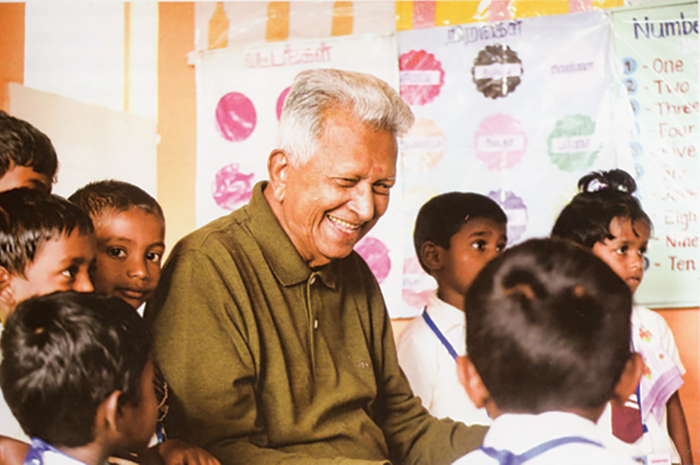
(Excerpted from the autobiography of Merrill J. Fernando)
Apart from livelihoods, post-tsunami, children’s education was one of the most deeply-affected dimensions. Our team established pre-schools for children in the affected areas and supplied teachers, specially trained by the Foundation not only to educate but also to handle emotional and physical trauma, resulting from the tsunami experience.
The outcomes of the educational assistance initiatives are probably most visible in the plantation sector, across three Regional Plantation Companies, benefiting several thousand children in terms of learning, equipment, accessories, and other facilities and, equally importantly, nutrition. At a higher level, bright students have been provided scholarships to enable them to pursue university education. This initiative has already produced two medical doctors and two lawyers, whilst there are five such students currently reading for their medical degrees in the medical faculties of the Jaffna, Rajarata, and Peradeniya Universities. The present judge in the Magistrate’s Court of Jaffna is also a direct beneficiary of the plantation residents’ scholarship programme.
The inadequacies of education in plantation areas are not visible to the mainstream because of the insular nature of the plantation society. Most plantation youth, male and female, because of overcrowded housing, a reluctance to engage in the traditional manual work of their parents, the desire for easy money, and the real need for augmenting family income, drop out very early from educational systems and seek employment outside.
However, due to lack of marketable skills and the minimalistic level of formal education, these youth are relegated to employment mostly below the blue collar level, condemning them and their progeny to the same vicious cycle of marginalization. Without assistance from specially-designed schemes, providing plantation youth access to higher education, the plantation sector will remain, well into the foreseeable future, a source of unskilled, low-paid labour, for the benefit of the more affluent external society.
The sweat and toil of our plantation workers, for over a century, have helped create billionaires in the other countries, in Europe and elsewhere, and in our country as well. I was first exposed to this culture of exploitation on my first visit to England, more than six decades ago when I underwent training as a Tea Taster at Mincing Lane, then the global centre of the tea trade. However, the worker who produces the tea, which enriches so many others in the commercial pipeline, remains marginalized. Unless the value created by the tea remains in the country and a surplus is channeled back for the workers’ benefit, as Dilmah is doing, the plantation worker’s lot will not change.
Personal experience
When I visited the tsunami-hit areas of the south, I saw for myself the impact of the devastation. I met children who had lost parents and siblings, and parents who had lost their children. People had lost homes and livelihoods. Some of these children had been so traumatized by their experiences, that they would not communicate or interact with society, in their silence and mute withdrawal, finding a measure of solace for an inexplicable tragedy.
Those who could muster the will to talk related the most harrowing tales of personal loss and deprivation. Listening to individual stories of such tragedies I felt so distressed that I could not even imagine how devastating it would have been to the individual who was telling me the story.
On one of his visits to the north, two doctors serving in the region had met Dilhan and requested him to build a new wing for the Accident Ward of the Kayts Hospital. I was not confident of the benefits of this kind of initiative, largely because of a disappointing experience previously with the Maharagama Cancer Hospital. The Foundation donated to the hospital a mammogram machine, which was idle for months after installation as the hospital did not provide X-ray film. However, Dilhan ascertained that the doctors who approached him were genuine and, about a year later, we completed construction of the new wing.
I attended the opening with my friend Ravi Thambiayah. After the ceremony, people of the area came and thanked me personally, assuring me that the new wing would actually save lives, which otherwise would be lost. Their gratitude was overwhelming. Such was their appreciation that they perceived me as an emissary of the gods they worshiped.
Apparently, in that area, people struck down by sudden and serious illnesses, snake-bites, and those injured in accidents, normally had to travel to the Jaffna Hospital, 16 km away and because of the inadequacy of transport facilities, two hours’ travel time away at best. With the new wing, such patients would be attended to within minutes. I was told that over 40,000 people were dependent on that hospital.
It takes little to enrich the lives of simple people, to whom the fulfillment of a basic need is an unexpected luxury. The Kayts experience encouraged me to extend the Foundation’s assistance in the north, and the next result was the construction of a new, three-storey, 90-bed ward block for the Point Pedro General Hospital, opened for operations in February 2021.
The existing ward buildings were over a century old and dilapidated, severely limiting the services the hospital could offer to over 150,000 people who depended on it. This initiative was co-sponsored, by the Ian and Barbara Karan Foundation for Youth Development. In fact, it was declared open on my behalf by Ian and his wife Barbara, in association with K. Ravindran and Rajan Asirwatham, both Trustees of the MJF Charitable Foundation, and my son Dilhan.
Symbolically, Ian Karan, my dear friend of many years, had been born in the very same hospital in 1939! Orphaned at a young age, he received his early education at Hartley College, Point Pedro. Thereafter, he entered the London School of Economics. Subsequently securing employment in a shipping company in Hamburg, in 1975 he set up a shipping company of his own.
Selling off that business in 1996, he established a container leasing company which, by the time he sold it a few years later, had become one of the largest such enterprises in the world. His foundation supports youth development, particularly in Sri Lanka, through the nationwide promotion of charitable initiatives, institutions, and projects. Like me, Ian is also a man of simple origins and strong in faith, who later became a successful entrepreneur. He too subscribes to the principle of the entrepreneur’s responsibility towards social justice.
Ian, Barbara, and his children became great friends with my family as well. All my visits to Hamburg included meetings with Ian and his family; knowing my fondness for opera and other performing arts, Ian and Barbara would ensure that my visits to them were enlivened by attendance at the Hamburg State Opera, for which they would very kindly get tickets for me.
The world of children – the dark side
I am haunted by the recurrent image of little children born with serious disabilities, undergoing rehabilitation and therapy, at both the Moratuwa and Kalkudah Centres. As a man with an abiding faith in a merciful God, the afflictions of such children is to me an inexplicable tragedy. Dilhan has always warned me against showing outward demonstrations of my distress on my visits to them, as that could upset the parents. However, I am also deeply grateful to providence that I have been able to contribute in some measure to make such lives more comfortable.
Children with congenital impairments are a heart-break for the concerned families. Down syndrome, cerebral palsy, and autism are conditions, which affected children and their families are compelled to live with till the end as there is no cure. Such children are marginalized and isolated, both by society and often by their own families. Both our Moratuwa and the East Centres provide for the care and training of disadvantaged children, as well as their family members, who need to be educated in the management and care of affected children. These programmes relieve parents from much of the pressure of caring for such children.
The stigmatization that such children are subject to by mainstream society, was brought home to me in a most unpleasant development soon after the commencement of the operations of the Ambagahawatte Centre, which specializes in the rehabilitation of children with cerebral palsy and other developmental disorders.
Families in the immediate neighbourhood protested at its purpose and activities, as they considered the housing of such disadvantaged children so close to their homes as potential for bad luck for themselves! Such superstitious and insensitive attitudes prevalent in mainstream society strongly reinforce the need for special initiatives to assist the disabled and to empower their families as well.
These children are also trained, educated, and stimulated by well-trained and caring staff to create art and, in various other ways, such as dance and theatre, to express themselves. Our annual MJF Centre ‘Celebrating Differences’ event, has become an ideal platform for the self-expression of these children, under normal circumstances condemned to lives of loneliness and an absence of recognition.
The performances that these differently-abled children produce year after year, with such self-confidence despite impediments to speech, movement, and cognition, are inspirational and deeply moving. What’s on display is not just child theatre, but, also, the power of love and caring. I witness this event every year and each time I am moved to tears.
Nipuna, one such child who has been with the Moratuwa Centre for several years, has become a child artist and improved his interpersonal skills to such an extent that we were able to place him in charge of a little restaurant we opened. Despite the inherent disadvantages of Down syndrome, he has developed to a stage where he considers himself an entrepreneur. He has told me very confidently that he wants to be a chairman of a company.
The progress of our initiatives with disabled children are signposted by such small, hard-won victories, but which loom large in the lives of those so enabled. One of the greatest joys of my life is seeing the beautiful smiles of little children, reflecting their joy at the liberation from congenital impediments.
There are other heart-warming moments, such as on a visit to an orphanage that the Foundation supports, when a blind child grabs Dilhan’s hand, smells his palm, and says with a brilliant smile: “This must be Mr. Dilhan.” To me, a little episode like that justifies all the resources that Dilmah diverts to the Foundation.
My world view
In the unforgiving world of big business and corporate enterprise, amid the relentless and mercenary crusade to become better, bigger, and more profitable, it is very easy to lose sight of the very society which big business feeds on; a society which consists largely of small people, struggling daily to make ends meet. The slightest disruption to the equilibrium of the diverse forces which regulate that society, whether through natural calamity, man-made conflict, or ungovernable economic disorder, immediately affects small people; they are the very first casualties of any upheaval as, their condition makes them the most vulnerable of our society.
A business cannot engage in charity at the expense of profit but, by the same token, a business cannot ignore the inequalities and inequities of the world in which it operates. A business creates genuine and lasting shareholder value when, within the means of its operation, it addresses those issues in the external society.
`Fair Trade’ has become a catchy slogan and the labels which carry that mantra provide comfort to civic-minded customers, who believe that part of what they pay for the product will go back to the producer. In the business reality of my perception, the ‘Fair Trade’ of corporate jargon is little more than marketing strategy, leveraged to perpetuate the existing system of multinational exploitation. In that system, from what the consumer pays at the cashier’s counter, the supermarket, the packer, the distributor, the importer, and the broker each get their piece of the action. The producer and the farmer are left with the crumbs off the table.
The ‘Fair Trade’ slogan has been introduced to marketing-speak by the multinationals because, after decades of exploitation along the chain, they have been compelled to accept the fact their trade has been, essentially, always unfair! In the hands of most traders, ‘Fair Trade’ has become a tool to gain the sympathy and support of the consumer, without genuinely addressing the consequences of unfair trade.
Genuinely fair trade presupposes the empowerment of the producer, but in reality very little of the value goes back to the farmer. Trade becomes genuinely fair only when earnings surplus is deployed in the country of origin, outside the ambit of the business, in caring for and empowering the marginalized and the indigent.
The country which grows the product is the best location for ‘Fair Trade’. That is what Dilmah does. Every cup of Dilmah tea, wherever in the world it is drunk, brings a measure of happiness, comfort, and empowerment, to either an individual or a community in need back in the country where the Dilmah tea is grown.
The needs of the disadvantaged in our society are many. Governments, which are shackled by bureaucratic restrictions, can only do so much and because of the size of the problem, that is insufficient. I know that I am also making a small impact within the means enabled by my business. But my view is that if all entrepreneurs make whatever contribution possible, addressing genuine community inadequacies in a sustainable manner, the world will become a much better place for the disadvantaged and the marginalized. I stand by my view, that every business must have a greater purpose which lies beyond profit.
After I launched the Foundation and its work got going in an organized manner, Dilhan kept bringing me more and more projects for sponsorship. I agreed to help with whatever resources I can divert for the cause and, despite my initial misgivings regarding the sustainability of our philanthropy, somehow the means have always appeared. The Bible says that the charity that you do is a gift to God and God repays you in abundance. In this world there is no shortage of wealth, but there is a great inequity in its distribution. Those who possess the means must correct that imbalance and that correction can be achieved only by sharing.
The fruits of the success of Dilmah have been many. It has provided employment to thousands, both here and abroad; it has also enriched many. In the process, it has carried across the world the message of the value of Pure Ceylon Tea and established its image as a desirable product in over 100 countries. It has brought me fame, fortune, recognition, and accolades. However, in my mind, its most valuable outcome is the goodness that I, along with my family, have been able to create with the value created by Dilmah. That will be its most enduring legacy.
‘Business as a Matter of Human Service’ is a responsibility we all share and that which we must all contribute to. What I shared with 18 of my workers six decades ago has, through the efforts of the many people who accompanied me on my long journey, and with the grace of God, increased exponentially and today benefits thousands of less-fortunate individuals and their families. As my friend Leighton Smith of New Zealand has expressed so very simply in his book, ‘Leighton Smith, Beyond the Microphone: “Merrill is an admirable example of how what you put out comes back to you; in his case, in droves… “
We come into this world with nothing, we leave with nothing. The wealth that some of us acquire is owed to the efforts and cooperation of many others around us. Let us, therefore, share that wealth while we are still around, so that the goodwill and contentment created thereby may make our world a happier place for others too.
Features
The heart-friendly health minister

by Dr Gotabhya Ranasinghe
Senior Consultant Cardiologist
National Hospital Sri Lanka
When we sought a meeting with Hon Dr. Ramesh Pathirana, Minister of Health, he graciously cleared his busy schedule to accommodate us. Renowned for his attentive listening and deep understanding, Minister Pathirana is dedicated to advancing the health sector. His openness and transparency exemplify the qualities of an exemplary politician and minister.
Dr. Palitha Mahipala, the current Health Secretary, demonstrates both commendable enthusiasm and unwavering support. This combination of attributes makes him a highly compatible colleague for the esteemed Minister of Health.
Our discussion centered on a project that has been in the works for the past 30 years, one that no other minister had managed to advance.
Minister Pathirana, however, recognized the project’s significance and its potential to revolutionize care for heart patients.
The project involves the construction of a state-of-the-art facility at the premises of the National Hospital Colombo. The project’s location within the premises of the National Hospital underscores its importance and relevance to the healthcare infrastructure of the nation.
This facility will include a cardiology building and a tertiary care center, equipped with the latest technology to handle and treat all types of heart-related conditions and surgeries.
Securing funding was a major milestone for this initiative. Minister Pathirana successfully obtained approval for a $40 billion loan from the Asian Development Bank. With the funding in place, the foundation stone is scheduled to be laid in September this year, and construction will begin in January 2025.
This project guarantees a consistent and uninterrupted supply of stents and related medications for heart patients. As a result, patients will have timely access to essential medical supplies during their treatment and recovery. By securing these critical resources, the project aims to enhance patient outcomes, minimize treatment delays, and maintain the highest standards of cardiac care.
Upon its fruition, this monumental building will serve as a beacon of hope and healing, symbolizing the unwavering dedication to improving patient outcomes and fostering a healthier society.We anticipate a future marked by significant progress and positive outcomes in Sri Lanka’s cardiovascular treatment landscape within the foreseeable timeframe.
Features
A LOVING TRIBUTE TO JESUIT FR. ALOYSIUS PIERIS ON HIS 90th BIRTHDAY

by Fr. Emmanuel Fernando, OMI
Jesuit Fr. Aloysius Pieris (affectionately called Fr. Aloy) celebrated his 90th birthday on April 9, 2024 and I, as the editor of our Oblate Journal, THE MISSIONARY OBLATE had gone to press by that time. Immediately I decided to publish an article, appreciating the untiring selfless services he continues to offer for inter-Faith dialogue, the renewal of the Catholic Church, his concern for the poor and the suffering Sri Lankan masses and to me, the present writer.
It was in 1988, when I was appointed Director of the Oblate Scholastics at Ampitiya by the then Oblate Provincial Fr. Anselm Silva, that I came to know Fr. Aloy more closely. Knowing well his expertise in matters spiritual, theological, Indological and pastoral, and with the collaborative spirit of my companion-formators, our Oblate Scholastics were sent to Tulana, the Research and Encounter Centre, Kelaniya, of which he is the Founder-Director, for ‘exposure-programmes’ on matters spiritual, biblical, theological and pastoral. Some of these dimensions according to my view and that of my companion-formators, were not available at the National Seminary, Ampitiya.
Ever since that time, our Oblate formators/ accompaniers at the Oblate Scholasticate, Ampitiya , have continued to send our Oblate Scholastics to Tulana Centre for deepening their insights and convictions regarding matters needed to serve the people in today’s context. Fr. Aloy also had tried very enthusiastically with the Oblate team headed by Frs. Oswald Firth and Clement Waidyasekara to begin a Theologate, directed by the Religious Congregations in Sri Lanka, for the contextual formation/ accompaniment of their members. It should very well be a desired goal of the Leaders / Provincials of the Religious Congregations.
Besides being a formator/accompanier at the Oblate Scholasticate, I was entrusted also with the task of editing and publishing our Oblate journal, ‘The Missionary Oblate’. To maintain the quality of the journal I continue to depend on Fr. Aloy for his thought-provoking and stimulating articles on Biblical Spirituality, Biblical Theology and Ecclesiology. I am very grateful to him for his generous assistance. Of late, his writings on renewal of the Church, initiated by Pope St. John XX111 and continued by Pope Francis through the Synodal path, published in our Oblate journal, enable our readers to focus their attention also on the needed renewal in the Catholic Church in Sri Lanka. Fr. Aloy appreciated very much the Synodal path adopted by the Jesuit Pope Francis for the renewal of the Church, rooted very much on prayerful discernment. In my Religious and presbyteral life, Fr.Aloy continues to be my spiritual animator / guide and ongoing formator / acccompanier.
Fr. Aloysius Pieris, BA Hons (Lond), LPh (SHC, India), STL (PFT, Naples), PhD (SLU/VC), ThD (Tilburg), D.Ltt (KU), has been one of the eminent Asian theologians well recognized internationally and one who has lectured and held visiting chairs in many universities both in the West and in the East. Many members of Religious Congregations from Asian countries have benefited from his lectures and guidance in the East Asian Pastoral Institute (EAPI) in Manila, Philippines. He had been a Theologian consulted by the Federation of Asian Bishops’ Conferences for many years. During his professorship at the Gregorian University in Rome, he was called to be a member of a special group of advisers on other religions consulted by Pope Paul VI.
Fr. Aloy is the author of more than 30 books and well over 500 Research Papers. Some of his books and articles have been translated and published in several countries. Among those books, one can find the following: 1) The Genesis of an Asian Theology of Liberation (An Autobiographical Excursus on the Art of Theologising in Asia, 2) An Asian Theology of Liberation, 3) Providential Timeliness of Vatican 11 (a long-overdue halt to a scandalous millennium, 4) Give Vatican 11 a chance, 5) Leadership in the Church, 6) Relishing our faith in working for justice (Themes for study and discussion), 7) A Message meant mainly, not exclusively for Jesuits (Background information necessary for helping Francis renew the Church), 8) Lent in Lanka (Reflections and Resolutions, 9) Love meets wisdom (A Christian Experience of Buddhism, 10) Fire and Water 11) God’s Reign for God’s poor, 12) Our Unhiddden Agenda (How we Jesuits work, pray and form our men). He is also the Editor of two journals, Vagdevi, Journal of Religious Reflection and Dialogue, New Series.
Fr. Aloy has a BA in Pali and Sanskrit from the University of London and a Ph.D in Buddhist Philosophy from the University of Sri Lankan, Vidyodaya Campus. On Nov. 23, 2019, he was awarded the prestigious honorary Doctorate of Literature (D.Litt) by the Chancellor of the University of Kelaniya, the Most Venerable Welamitiyawe Dharmakirthi Sri Kusala Dhamma Thera.
Fr. Aloy continues to be a promoter of Gospel values and virtues. Justice as a constitutive dimension of love and social concern for the downtrodden masses are very much noted in his life and work. He had very much appreciated the commitment of the late Fr. Joseph (Joe) Fernando, the National Director of the Social and Economic Centre (SEDEC) for the poor.
In Sri Lanka, a few religious Congregations – the Good Shepherd Sisters, the Christian Brothers, the Marist Brothers and the Oblates – have invited him to animate their members especially during their Provincial Congresses, Chapters and International Conferences. The mainline Christian Churches also have sought his advice and followed his seminars. I, for one, regret very much, that the Sri Lankan authorities of the Catholic Church –today’s Hierarchy—- have not sought Fr.
Aloy’s expertise for the renewal of the Catholic Church in Sri Lanka and thus have not benefited from the immense store of wisdom and insight that he can offer to our local Church while the Sri Lankan bishops who governed the Catholic church in the immediate aftermath of the Second Vatican Council (Edmund Fernando OMI, Anthony de Saram, Leo Nanayakkara OSB, Frank Marcus Fernando, Paul Perera,) visited him and consulted him on many matters. Among the Tamil Bishops, Bishop Rayappu Joseph was keeping close contact with him and Bishop J. Deogupillai hosted him and his team visiting him after the horrible Black July massacre of Tamils.
Features
A fairy tale, success or debacle

Sri Lanka-Singapore Free Trade Agreement
By Gomi Senadhira
senadhiragomi@gmail.com
“You might tell fairy tales, but the progress of a country cannot be achieved through such narratives. A country cannot be developed by making false promises. The country moved backward because of the electoral promises made by political parties throughout time. We have witnessed that the ultimate result of this is the country becoming bankrupt. Unfortunately, many segments of the population have not come to realize this yet.” – President Ranil Wickremesinghe, 2024 Budget speech
Any Sri Lankan would agree with the above words of President Wickremesinghe on the false promises our politicians and officials make and the fairy tales they narrate which bankrupted this country. So, to understand this, let’s look at one such fairy tale with lots of false promises; Ranil Wickremesinghe’s greatest achievement in the area of international trade and investment promotion during the Yahapalana period, Sri Lanka-Singapore Free Trade Agreement (SLSFTA).
It is appropriate and timely to do it now as Finance Minister Wickremesinghe has just presented to parliament a bill on the National Policy on Economic Transformation which includes the establishment of an Office for International Trade and the Sri Lanka Institute of Economics and International Trade.
Was SLSFTA a “Cleverly negotiated Free Trade Agreement” as stated by the (former) Minister of Development Strategies and International Trade Malik Samarawickrama during the Parliamentary Debate on the SLSFTA in July 2018, or a colossal blunder covered up with lies, false promises, and fairy tales? After SLSFTA was signed there were a number of fairy tales published on this agreement by the Ministry of Development Strategies and International, Institute of Policy Studies, and others.
However, for this article, I would like to limit my comments to the speech by Minister Samarawickrama during the Parliamentary Debate, and the two most important areas in the agreement which were covered up with lies, fairy tales, and false promises, namely: revenue loss for Sri Lanka and Investment from Singapore. On the other important area, “Waste products dumping” I do not want to comment here as I have written extensively on the issue.
1. The revenue loss
During the Parliamentary Debate in July 2018, Minister Samarawickrama stated “…. let me reiterate that this FTA with Singapore has been very cleverly negotiated by us…. The liberalisation programme under this FTA has been carefully designed to have the least impact on domestic industry and revenue collection. We have included all revenue sensitive items in the negative list of items which will not be subject to removal of tariff. Therefore, 97.8% revenue from Customs duty is protected. Our tariff liberalisation will take place over a period of 12-15 years! In fact, the revenue earned through tariffs on goods imported from Singapore last year was Rs. 35 billion.
The revenue loss for over the next 15 years due to the FTA is only Rs. 733 million– which when annualised, on average, is just Rs. 51 million. That is just 0.14% per year! So anyone who claims the Singapore FTA causes revenue loss to the Government cannot do basic arithmetic! Mr. Speaker, in conclusion, I call on my fellow members of this House – don’t mislead the public with baseless criticism that is not grounded in facts. Don’t look at petty politics and use these issues for your own political survival.”
I was surprised to read the minister’s speech because an article published in January 2018 in “The Straits Times“, based on information released by the Singaporean Negotiators stated, “…. With the FTA, tariff savings for Singapore exports are estimated to hit $10 million annually“.
As the annual tariff savings (that is the revenue loss for Sri Lanka) calculated by the Singaporean Negotiators, Singaporean $ 10 million (Sri Lankan rupees 1,200 million in 2018) was way above the rupees’ 733 million revenue loss for 15 years estimated by the Sri Lankan negotiators, it was clear to any observer that one of the parties to the agreement had not done the basic arithmetic!
Six years later, according to a report published by “The Morning” newspaper, speaking at the Committee on Public Finance (COPF) on 7th May 2024, Mr Samarawickrama’s chief trade negotiator K.J. Weerasinghehad had admitted “…. that forecasted revenue loss for the Government of Sri Lanka through the Singapore FTA is Rs. 450 million in 2023 and Rs. 1.3 billion in 2024.”
If these numbers are correct, as tariff liberalisation under the SLSFTA has just started, we will pass Rs 2 billion very soon. Then, the question is how Sri Lanka’s trade negotiators made such a colossal blunder. Didn’t they do their basic arithmetic? If they didn’t know how to do basic arithmetic they should have at least done their basic readings. For example, the headline of the article published in The Straits Times in January 2018 was “Singapore, Sri Lanka sign FTA, annual savings of $10m expected”.
Anyway, as Sri Lanka’s chief negotiator reiterated at the COPF meeting that “…. since 99% of the tariffs in Singapore have zero rates of duty, Sri Lanka has agreed on 80% tariff liberalisation over a period of 15 years while expecting Singapore investments to address the imbalance in trade,” let’s turn towards investment.
Investment from Singapore
In July 2018, speaking during the Parliamentary Debate on the FTA this is what Minister Malik Samarawickrama stated on investment from Singapore, “Already, thanks to this FTA, in just the past two-and-a-half months since the agreement came into effect we have received a proposal from Singapore for investment amounting to $ 14.8 billion in an oil refinery for export of petroleum products. In addition, we have proposals for a steel manufacturing plant for exports ($ 1 billion investment), flour milling plant ($ 50 million), sugar refinery ($ 200 million). This adds up to more than $ 16.05 billion in the pipeline on these projects alone.
And all of these projects will create thousands of more jobs for our people. In principle approval has already been granted by the BOI and the investors are awaiting the release of land the environmental approvals to commence the project.
I request the Opposition and those with vested interests to change their narrow-minded thinking and join us to develop our country. We must always look at what is best for the whole community, not just the few who may oppose. We owe it to our people to courageously take decisions that will change their lives for the better.”
According to the media report I quoted earlier, speaking at the Committee on Public Finance (COPF) Chief Negotiator Weerasinghe has admitted that Sri Lanka was not happy with overall Singapore investments that have come in the past few years in return for the trade liberalisation under the Singapore-Sri Lanka Free Trade Agreement. He has added that between 2021 and 2023 the total investment from Singapore had been around $162 million!
What happened to those projects worth $16 billion negotiated, thanks to the SLSFTA, in just the two-and-a-half months after the agreement came into effect and approved by the BOI? I do not know about the steel manufacturing plant for exports ($ 1 billion investment), flour milling plant ($ 50 million) and sugar refinery ($ 200 million).
However, story of the multibillion-dollar investment in the Petroleum Refinery unfolded in a manner that would qualify it as the best fairy tale with false promises presented by our politicians and the officials, prior to 2019 elections.
Though many Sri Lankans got to know, through the media which repeatedly highlighted a plethora of issues surrounding the project and the questionable credentials of the Singaporean investor, the construction work on the Mirrijiwela Oil Refinery along with the cement factory began on the24th of March 2019 with a bang and Minister Ranil Wickremesinghe and his ministers along with the foreign and local dignitaries laid the foundation stones.
That was few months before the 2019 Presidential elections. Inaugurating the construction work Prime Minister Ranil Wickremesinghe said the projects will create thousands of job opportunities in the area and surrounding districts.
The oil refinery, which was to be built over 200 acres of land, with the capacity to refine 200,000 barrels of crude oil per day, was to generate US$7 billion of exports and create 1,500 direct and 3,000 indirect jobs. The construction of the refinery was to be completed in 44 months. Four years later, in August 2023 the Cabinet of Ministers approved the proposal presented by President Ranil Wickremesinghe to cancel the agreement with the investors of the refinery as the project has not been implemented! Can they explain to the country how much money was wasted to produce that fairy tale?
It is obvious that the President, ministers, and officials had made huge blunders and had deliberately misled the public and the parliament on the revenue loss and potential investment from SLSFTA with fairy tales and false promises.
As the president himself said, a country cannot be developed by making false promises or with fairy tales and these false promises and fairy tales had bankrupted the country. “Unfortunately, many segments of the population have not come to realize this yet”.
(The writer, a specialist and an activist on trade and development issues . )

